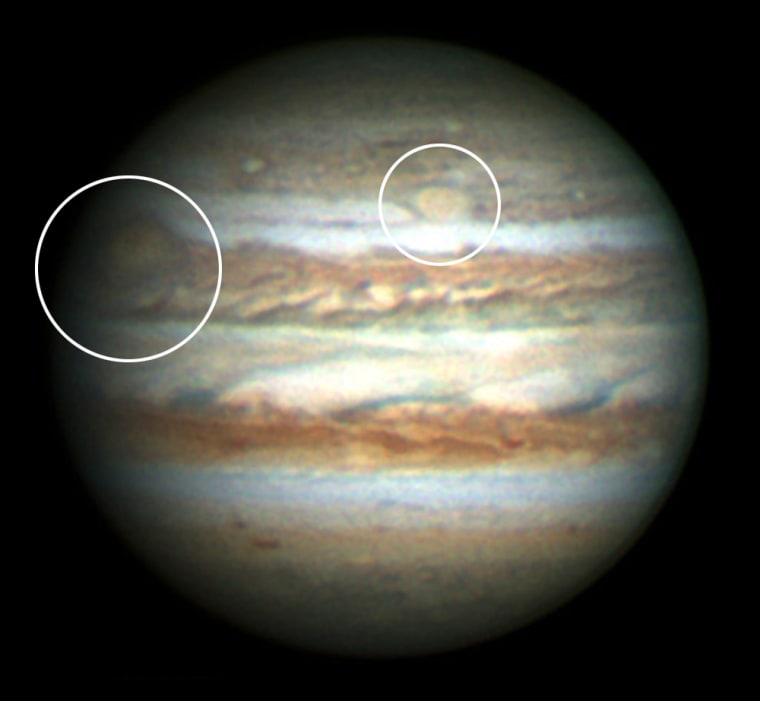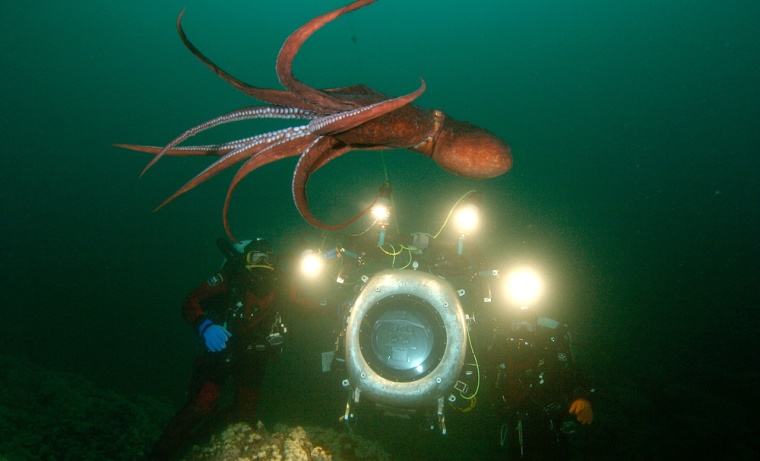• |
Star-studded show: In the latest picture from NASA's Spitzer Space Telescope, the galaxy cluster known as Stephan’s Quintet is dressed up in colors befitting a red-carpet turn at the Oscars.
The neon hues reflect patterns of colliding gas that can be analyzed much better in infrared wavelengths than in the visible light spectrum. The colorized results document an intergalactic crash as titanic as ... well, "Titanic" or "Crash."
The key area is the greenish arc, which indicates the shock wave produced as one galaxy falls toward another at more than a million miles an hour. The green glow is the infrared signature of highly disturbed hydrogen gas. In the image advisory, Spitzer's scientists say the green glow represents "the most turbulent molecular hydrogen ever seen."
The galaxies show up as yellow and pinkish knots wrapped within bluish clouds of stars. The infalling galaxy, NGC 7318b, is the spot just to the right of the green arc. In this picture, the large spiral galaxy at lower left is a foreground object — an extra that really doesn't play a role in the main drama.
Astronomers are trying to figure out why the hydrogen emission from the shock wave is so strong — and they suspect it's due to NGC 7318b's "sonic boom" effect.
"In Stephan's Quintet, the shock wave is due to the intruder galaxy traveling at speeds greater than Mach 100 as it plows into intergalactic gas within the cluster," Philip Appleton of the California Institute of Technology says in a Spitzer feature on the observations.
Astronomer Richard Tuffs expands upon the sonic-boom metaphor in a news release from the Max Planck Society in Germany:
"One can think of the shock waves created by supersonic aircraft in the Earth atmosphere," he said. "There, water droplets can condense behind the shock in humid conditions, while in Stephan's Quintet, hydrogen molecules could form out of a turbulent and cooling intergalactic medium. Of course, all this is happening on an enormous scale in Stephan's Quintet."
The researchers say studying Stephan's Quintet may give them a better understanding of what happened 10 billion years ago, when young galaxies were crashing through the universe's denser intergalactic medium. Such cosmic collisions may also explain the curiously strong emissions seen from ultraluminous infrared galaxies.
The full report on Spitzer's latest revelation appears in the March 10 issue of The Astrophysical Journal Letters. For more subdued views of Stephan's Quintet, check out this Hubble imagery as well as this perspective from the Kitt Peak National Observatory. And for yet another cosmic mash-up, click on through to an earlier posting on the galactic "Fab Four."
• |
Little Red Spot: Along with Saturn's rings, Jupiter's Great Red Spot would have to rank among the most recognizable planetary features in the solar system. No one could confuse the stormy spot with anything else — but now Jupiter is sprouting yet another spot that astronomers are calling the "not-so-Great Red Spot" or "Red Jr."

The spot, known more formally as Oval BA, is actually a whirling storm system that was formed in 2000 through the merger of two smaller "Jupiter-ricanes." Until recently, the spot was white, but as the storm strengthened, astrophotographer Christopher Go in the Philippines noticed that Oval BA was taking on the same hue seen in the Great Red Spot.
Scientists don't know exactly why the Great Red Spot is red, but they suspect it has something to do with chemical reactions linked to storm intensity and altitude. The fact that Red Jr. is turning the same color lends support to that hypothesis.
Check out Science @ NASA for a detailed report, including advice for spotting Jupiter and its spots in the night sky. Go's Web site provides plenty of imagery and information.
• |
Proofs for pickup lines: Back on Valentine's Day, we discussed a scientific experiment on the efficacy of pickup lines, which led researchers to the conclusion that canned, corny intros and macho preening don't work as well as chivalrous gestures. Who knew!?
Anyway, the reader feedback tends to support those findings. Here are a couple of examples:
Dana: "A guy actually walked up to me and said, 'Excuse me, but my Porsche is in the shop so I've had to use my Mercedes, do you know a good detail place around here?' The sad thing is, I could tell by his arrogant, obnoxious attitude that he really thought I'd be impressed. Yuck!"Amanda: "In high school, there was this guy who thought it was funny to come up to me and spout off pickup lines in my direction. I heard almost every line known to man, and I frequently asked him (or yelled at him, depending on the day) to stop. I knew he wasn't serious and that he didn't like me and that he wouldn't be bothering me if he did, and it made me feel like crap."I feel the need to share one of the cheesiest and possibly most original pickup lines that has been burnt like a cattle brand into my memory. I was walking outside from one class to the next, and he comes up to me. 'You see that guy over there?' (He points to a spot in the grass occupied by no one.) 'He likes you.' He then scampers over to the spot he just pointed to and strikes a 'manly' pose with his fists on his hips and his 'triumphant' face toward the top of the flagpole."Eventually I got so fed up with him that I banned him from any communication with me. But I will always remember this moron who never learned when to quit."
Despite the negative results, determined experimenters will probably press on, as evidenced by this suggestion for a scientific pickup line:
Anonymous: "Scientifically speaking, is that just a hunk of compressed carbon on your finger, or are you really married?"
• |
Coming attractions: What cosmic secrets are locked within the specks of comet dust brought back to Earth by NASA's Stardust spacecraft? The mission's principal investigator, Don Brownlee of the University of Washington, provided a preview of the initial findings in St. Louis at last month's annual meeting of the American Association for the Advancement of Science. But he and his fellow researchers are holding back the best stuff for this month's Lunar and Planetary Science Conference in Texas.
On Thursday night, Brownlee hinted that the best stuff is pretty juicy. About 25 of us were in the audience for his talk at the UW, presented by the Northwest Science Writers Association. Brownlee said that so far, there wasn't much internal wrangling among the members of the Stardust science team, because they were still teasing out the data. But that could change, he said:
"There will be things that people will discuss. In fact, we will announce something in March [at the conference] that people will probably discuss for 10, 20 years what the significance of it actually is."
My colleague at the Seattle Post-Intelligencer, health/science reporter Tom Paulson, piped right up: "What is it?" The room erupted in laughter. No way was Brownlee going to spill the secret early.
"Well, we'll see," Brownlee said as the laughs subsided. "But we do have some interesting stuff."
• March 3, 2006 |
Weekend field trips on the World Wide Web:
• Discovery.com: Personal plane flies and drives
• The Economist: Facing the truth about rugged good looks• Archaeology Magazine: Artful surgery
• New Scientist: Astronauts plan history's longest golf drive
• |
See the 3-D sea: Back in the early 1990s, filmmaker Howard Hall directed Imax's first underwater 3-D documentary, "Into the Deep," at a time when the bugs were still being worked out of the technology. Now he and his crew have gone back in the water for a wider-ranging exploration of the ocean and its creatures — tailor-made for 3-D viewing on six-story-high screens.
Hall's latest tour, "Deep Sea 3D," takes advantage of more than a decade's worth of new technology, which allowed the filmmakers to travel around the world in search of eye-popping marine life. But the 40-minute film, which premieres Friday in Imax theaters, isn't mere eye candy: There's a serious scientific message that Hall and his wife, producer Michele Hall, are trying to get across.
"What we wanted to show with this film is how species are dependent upon each other for their survival," Michele Hall told me, "and then show what happens if species begin to disappear."
For example, sharks are in the midst of a worldwide decline due to overfishing, and that means the fish that sharks normally feed on are on the increase. That puts pressure on competing species of fish that keep coral reefs clean by grazing on algae. As a result, the reefs are in sadder shape.
"You’ve heard the term ‘biodiversity,’ but people haven’t really been told why it's important," Howard Hall said. "It seems like it’s just been left hanging. The reason biodiversity is important is because ecosystems are communities, and animals depend on each other in either predator-prey relationships or symbiotic relationships. ... If you remove too many species, whole ecosystems break down."
The past decade has not been kind to the world's oceans, he said.
"We're learning more about where these animals live and where to go to find them, and what they do," he observed. "At the same time, there are fewer and fewer animals all the time. During the period between this film and 'Into the Deep,' there have been some really major changes in the oceans. For the most part, there's just essentially less of almost everything. … During those 10 years we’ve watched populations of animals disappear, especially coral reef ecosystems that have just died off."
Fortunately, the Halls and their crew still found wonders galore — including a faceoff between a Mantis shrimp and an octopus off California's coast, a gaggle of green sea turtles near Hawaii, and the annual coral spawning at the Flower Garden Banks National Marine Sanctuary in the Gulf of Mexico.
Scientists have pinpointed the time of spawning as the eighth night after the full moon in August, and the film crew was there at just the right time. "It's like watching something out of the Hubble Space Telescope — galaxies of eggs release in huge drifting clouds," producer Toni Myers said in the production notes (PDF file).
The crew got out at just the right time as well. "Hurricane Katrina came in the day after we finished the sequence," Howard Hall recalled.
Some of the other underwater sagas filmed for giant 3-D screens are sweetened with computer-generated graphics — "Ghosts of the Abyss" and "Aliens of the Deep" come to mind. But the Halls take pride in saying that everything in their films are just as they appeared in real life. In fact, the film was painstakingly scripted to capitalize on 3-D realism — even if it meant passing up crowd-pleasing whales and dolphins.
"Every subject that we chose, and every sequence that we chose, we chose because we knew they would produce a good 3-D effect. That means animals that are going to come close enough to where you feel like you can reach out and touch them," Howard Hall said.

Filming the movie was no underwater picnic: The 3-D camera equipment weighed 1,300 pounds (590 kilograms), and that doesn't count the lights, power and all the other equipment that's required. To achieve the Imax 3-D effect, two sets of lenses are set just inches apart, recording the scene on two spools of 70mm film. A maximum of seven minutes can be shot before the film has to be changed.
"It's about as impractical a wildlife-filming format as you can possibly imagine, and in a perverse way, that makes it fun. ... When we succeed at something, it's so gratifying," Howard Hall said.
The two views are blended through a special projection system in the theater, and filmgoers are issued oversized, polarized glasses that trick the eyes into seeing 3-D images (Xeni Jardin and Sean Bonner make a fashion statement on BoingBoing).
"When you're sitting in the theater and you're looking through the glasses at the film, you're seeing an image that is virtually identical to what we saw through our diving mask," Howard Hall said. "That's what this technology does best. It actually re-creates the visual reality that we experienced when we were there."
• March 2, 2006 |
Must-see science on the World Wide Web:
• Nature: Surprise organ discovered in mice
• EMBL: New tree of life gives closer look at origin of species
• Wired: Is RFID a sign of the (end) times?
• BBC: Ground-based telescopes 'worthless' by 2050
• |
Round-the-moon rescue? What can you do with a satellite in a useless orbit? That's the question now facing the folks who built, launched and hoped to use the Arabsat 4A telecommunications satellite — and one of the potential answers could involve an unorthodox trip all the way around the moon to get the orbit back in sync.
The problem arose on Wednesday when the upper stage of a Russian Proton-M rocket malfunctioned, leaving Arabsat in an orbit too low for the job it was designed to do. It's a big setback for the Russians, who launched the Proton from their Baikonur Cosmodrome in Kazakhstan — and it's a headache as well for the Saudi-based Arabsat consortium, the EADS Astrium company that built the satellite, and the insurers who have to make good on the loss.
It's not clear whether Arabsat's orbit can be raised to the right place as it circles the earth. NBC News space analyst James Oberg reports that satellite experts are considering an alternative trajectory that would slingshot the satellite around the moon and back. Believe it or not, that strategy has been used before to salvage a satellite gone awry.
On Christmas Day 1997, a similarly problematic Proton launch left the Asiasat 3 satellite in a similarly useless orbit, apparently a total loss. Hughes Global Services, the satellite's manufacturer, bought Asiasat back from the insurers — then gave it a new lease on life by sending it on a "free return lunar flyby."
After making a round-the-moon trip and going through another corrective maneuver, the satellite — renamed HGS-1 — settled into a nice, circular orbit. Since then, the craft was acquired by PanAmSat, given yet another name (PAS 22), and moved into yet another telecommunications slot.
In an e-mail, Oberg says that the folks behind the Asiasat maneuver are now in touch with the parties considering Arabsat's fate, and that all the parties involved may work out a rescue plan in the days ahead:
"A mission rescue via lunar swingby is under serious consideration, but issues of ownership remain to be settled. And even if the probe cannot be moved into an operational 24-hour orbit, it can certainly be sent out to the moon on an Arab space mission. ... The Saudis would love it."
Stay tuned for the next installment in Arabsat's space saga. It's worth noting that just such a round-the-moon trip is being offered as a $100 million-a-ticket ride for private space travelers.
• |
Visions of Venus: An otherworldly, ominously orange landscape has taken the top prize in the Planetary Society's "Postcards From Venus" art contest, earning a trip to European mission control for the 17-year-old artist.

Tatianna Cwick of Cape Girardeau, Mo., and a guardian will be heading to the European Space Operations Center in Darmstadt, Germany, to witness the arrival of the Venus Express orbiter at its interplanetary destination on April 11.
In honor of the orbiter's mission, the Planetary Society's contest solicited artistic visions of Venus, and hundreds of artworks were submitted. Judges recognized Cwick's rendition as the grand-prize winner. They also gave special recognition to 18 other works from around the world in adult and youth categories. Check out the Planetary Society's virtual gallery for the honorees.
In today's announcement, Cwick said she thinks her entry "captures the essence of the planet Venus, with its threatening volcanic environment and unique splendor."
Emily Lakdawalla, the Planetary Society's science and technology coordinator (and blogger), said lots of the entries accurately painted Venus as a hellish place, but the judges were looking for something heavenly as well.
"They definitely were looking for artwork that felt like Venus, but they also wanted to enjoy the landscape they were looking at, and see it as someplace they would want to visit," Lakdawalla told me.
Lakdawalla said Venus often gets a bad rap — just because it has a cloud cover of sulfuric acid, surface temperatures hot enough to melt lead, and crushing atmospheric pressure. She said there's an austere beauty to the planet's dramatic mountain ranges, volcanoes and "really gorgeous impact craters."
Venus has been visited before, by the Russian Venera probes as well as NASA's Magellan orbiter. But once Venus Express begins its work, scientists expect to get a much better handle on the hothouse planet and its environs. About two months after the orbiter's arrival, another set of judges — including some members of the Venus Express team — will review the artwork again to select the two entries that most closely resemble the mission's views of the planet.
It's a safe bet that those entries won't make Venus look like anything you'd want to write "wish you were here" about — unless you were sending a postcard to your worst enemy. In fact, Sciam Observations is picking up on that theme by soliciting suggestions for things to write on the back of Venusian postcards. Hmmm ... wish I'd thought of that.
• March 1, 2006 |
Wonder and whimsy on the World Wide Web:
• U. of Houston via EurekAlert: Sex ... Why bother?
• Marginal Revolution: Make money on eBay (via GeekPress)
• Mini-AIR: Polymaths, cat-fungus limericks and more
• The Onion: Rotation of Earth plunges America into darkness
• |
Grand, gargantuan galaxy: The Pinwheel Galaxy gets the HDTV treatment — high-definition telescope view — in the latest offering from the Hubble Space Telescope.
The Hubble composite image of the galaxy, also known as Messier 101 or M101, was assembled from 51 individual exposures snagged between 1994 and 2003. In its largest-resolution version, the image measures 16,000 by 12,000 pixels — the equivalent of 192 megapixels. It's available online as a 442-megabyte file, and you can also explore a zoomable version or watch a video.

As usual, there's a scientific point behind all that effort. Actually, more than one point. Through the years, the Hubble observations were aimed at answering questions relating to the expansion rate of the universe, the genesis of star clusters, the search for blue supergiant stars and the sources of intense X-ray emissions in M101.
One group of astronomers, led by K.D. Kuntz of Johns Hopkins University and NASA, used the imagery to catalog nearly 3,000 previously undetected star clusters, according to today's image advisory from the European Space Agency. Hubble could make out millions of individual stars in the galaxy, and even spot more distant galaxies on the other side of the Pinwheel's thin disk.
The Pinwheel is a popular target for astronomical observations, sitting in the constellation of Ursa Major about 25 million light-years from Earth. It's nearly twice as wide as our own Milky Way, containing an estimated trillion stars. The galaxy is known as a "grand design spiral" because of its classic swirly shape.
The mosaic view released today represents Hubble's largest and most detailed portrait of a galaxy beyond our own — but as Sky & Telescope points out, it's not the absolute record-holder. Astrophotographer Robert Gendler has assembled an even larger mosaic image of the Andromeda Galaxy, amounting to a whopping 316.6 megapixels.
• |
Asteroid alert: "Not to start a panic or anything," Doug Fingles writes from Warner Robins, Ga., "but you might be interested to know that 2004 VD17 just popped up to Level 2 on the Torino Scale. It's not projected to make its close pass until 2102, so not much to worry about ... yet."
Fingles is right on both counts: It is indeed interesting that the currently calculated orbit for asteroid 2004 VD17 could result in a collision with Earth on May 4, 2102 (or on the same date two years later). Right now the chances of a collision are set at 1 out of 1,560. In comparison, astronomers set the "background risk" for a collision with an asteroid or comet wider than a kilometer in any given year at roughly 1 out of 100,000 or so.
The perceived risk associated with comet predictions generally arises because the orbits are not precisely known. As the orbit becomes better-known, the risk almost always goes away — and the chances are pretty good that this will turn out to be the case with 2004 VD17.
The rise in the Torino rating from 1 to 2 isn't anything to get worried about. "While meriting attention by astronomers, there is no cause for public attention or public concern, as an actual collision is very unlikely," according to the Torino Scale definition.
Meanwhile, the asteroid Apophis is still on NASA's hazard watch list, with a perceived collision risk of 1 out of 5,880 for the year 2036. As we've reported previously, that asteroid will be monitored for years to come, and NASA has devised a plan to deal with any threat that may persist. If you want to keep watch on the impact risks, or merely get yourself in the mood for watching "Armageddon" or "Deep Impact," check in with NASA's Near Earth Object Program.
• |
The Altair era? NASASpaceFlight.com passes along yet another report that NASA officials are closing in on "notional names" for the agency's future spaceships: Altair for the Crew Expedition Vehicle, Ares 1 and Ares 5 for the crew-launch rocket and the heavy-lift rocket, and Artemis for the lunar lander.
We've talked about the A-list before, but in this most recently reported configuration, the name for the crew vehicles goes from Antares (Greek for "rival of Mars," as well as the name of the brightest star in the constellation Scorpius) to Altair (Arabic for "flying eagle," and the brightest star in the constellation Aquila).
Altair has a nice sound to it, and I can easily imagine looking forward to the Altair 11 mission to the moon. But there might be a little brand-name confusion with Sprague Astronautics' Altairis rocket — that is, assuming that the Altairis gets off the ground.
• |
Join the CLUB Club: In light of the past week's discussion of alien worlds and science fiction, this seems as good a time as any to slide in a recommendation for Orson Scott Card's "Ender's Game" as this month's selection for the Cosmic Log Used Book Club. Our low-budget club highlights books with cosmic themes that have been out long enough to show up in used-book shops or your local library.
Card's classic — which traces the grooming of an outer-space military master for interplanetary war — was published back in 1985, just as the U.S.-Soviet superpower standoff was entering its final phase. But it seems as if the saga was written for the post-9/11 world, where the "enemy" is a shadowy, never-seen presence, and where even the "good guys" are no angels.
There has been more than one attempt to adapt "Ender's Game" as a movie, and just this month, Card announced on his Web forum that he was working on a screenplay for Warner Bros. To get Card's perspective on current events, check out "The Ornery American." And to nominate future CLUB Club selections, just drop me a line.
• Feb. 28, 2006 |
Scientific smorgasbord on the World Wide Web:
• N.Y. Times (reg. req.): Thrill ride to the 'other side of infinity'
• Gamasutra: Are video games addictive? (via Slashdot)
• New Scientist: 3-D plasma shapes created in thin air
• Flight Int'l: Watch historic video of V-2 flight over New Mexico
• |
Olympic gold for economists: The widest-ranging sport of the Turin Olympics wasn't speedskating or ski jumping — it was guessing what the medal count would turn out to be. And this year, the gold medal would probably have to go to a two-man team of Dutch economists who outpredicted the sports jocks.
Before the Olympics began, I listed some of the predictions that were based on economic and geographical factors alone, and I noted that the U.S. medal counts in those predictions were generally lower than what the sportswriters were citing, based on sport-by-sport comparisons.
In the 2004 Olympics, the jocks' optimism about the Americans' chances came close to the mark, beating out the gloomier projections from the economics geeks. This time the tables were turned, and the geeks beat the jocks. In the jocks' defense, you might say that no one could have predicted skater Michelle Kwan's withdrawal or skier Bode Miller's flame-out — but from the geeks' point of view, that's beside the point. Ideally, the individual agonies and thrills average out to produce a cold, hard statistic.
So here's how the numbers came out: The U.S. team came in second in total medals with 25, including nine gold. The post-Games spin from the U.S. Olympic Committee is that the count exceeded expectations, but before the Games, the general sense among sportswriters had been that the total U.S. medal count would be in the 30-36 range.
In contrast, the economists' predictions were in the 22-31 range. Of the three sets of predictions cited two weeks ago, Dutch economists Gerard Kuper and Elmer Sterken came the closest to reality. They predicted 24 medals for the Americans, including 10 gold.
All the economic-based predictions correctly identified Germany as No. 1 on the medals chart, but Colorado College's Daniel K.N. Johnson came the closest — predicting 28 total medals with 10 gold for the Germans, as compared with the actual figures of 29 total and 11 gold.
The fact that the U.S. team was significantly off its chart-leading pace from the 2002 Winter Olympics in Utah (when the Americans took 34 medals in all) would argue that the "host effect" was a contributor to the 2002 figures. The host effect refers to the idea that the country hosting the Olympics in a given year has an added motivation for doing well, and thus puts in extra funding and effort to win extra medals.
If the effect holds true, you can look forward to a hefty medal count for the Chinese in 2008 as well as the Canadians in 2010. Even this year, those two countries did better than Johnson and Tokyo-based researcher Wade Pfau predicted — while Kuper and Sterken nailed the Canadian and Chinese counts to within two. So in their honor, here's a slightly-smaller-than-Olympic-size playing of the Dutch national anthem.
• |
Deals in the space race: The deadlines are looming for NASA's program to promote private-sector supply services for the international space station, known as Commercial Orbital Transportation Services or COTS. That means space entrepreneurs are scurrying to submit their proposals for spaceship concepts, in hopes of getting a piece of the $500 million budgeted for such space services through 2010.
Even before Friday's deadline, there's a buzz over who is teaming up with whom: The weekly Space News reports that Oklahoma-based Rocketplane's majority owner, George French, has bought Kirkland, Wash.-based Kistler Aerospace with an eye toward submitting a COTS proposal.
The Canadian-American PlanetSpace venture is teaming up with some better-known aerospace partners on a COTS plan that could be based on its recently announced Silver Dart concept. Transformational Space has been taking the team approach from the start, drawing upon expertise from Scaled Composites, AirLaunch LLC, Constellation Services International and other outfits.
Meanwhile, California-based SpaceDev's founder and chairman, Jim Benson, told me today that he is partnering "with very experienced, household-name companies" on his Dream Chaser concept, although he declined to name the companies.
"The big question is, is NASA going to follow through or not?" Benson said.
He recalled that his company had once prepared a study on lunar-lander architecture for NASA, with the hope that the job of developing the low-cost lander would be given to the private sector. Instead, NASA's own centers were put in charge of the project.
"I'm hopeful that COTS isn't going to do that," Benson said.
• Feb. 27, 2006 |
Your daily dose of science on the Web:
• Science News: Quantum computer gives results without running
• Discovery.com: Early humans were often eaten
• Discover Magazine: Unintelligent design
• Popular Science: Ready for takeoff?
Looking for older items? Check the . Share your perspective on cosmic subjects with . If you link to this page, you can use or as the address. MSNBC is not responsible for the content of Internet links.
